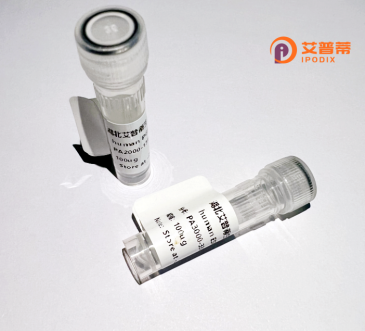
| 纯度 | >90%SDS-PAGE. |
| 种属 | Human |
| 靶点 | ZC3H7A |
| Uniprot No | Q8IWR0 |
| 内毒素 | < 0.01EU/μg |
| 表达宿主 | E.coli |
| 表达区间 | 1-167 aa |
| 活性数据 | MKENGIQDMEQFYELWLKSQKNEKSEDIASQSNKENGKQIHMPTDYAEVTVDFHCWMCGKNCNSEKQWQGHISSEKHKEKVFHTEDDQYCWQHRFPTGYFSICDRYMNGTCPEGNSCKFAHGNAELHEWEERRDALKMKLNKARKDHLIGPNDNDFGKYSFLFKDLN |
| 分子量 | 46.2 kDa |
| 蛋白标签 | GST-tag at N-terminal |
| 缓冲液 | PBS, pH7.4, containing 0.01% SKL, 1mM DTT, 5% Trehalose and Proclin300. |
| 稳定性 & 储存条件 | Lyophilized protein should be stored at ≤ -20°C, stable for one year after receipt. Reconstituted protein solution can be stored at 2-8°C for 2-7 days. Aliquots of reconstituted samples are stable at ≤ -20°C for 3 months. |
| 复溶 | Always centrifuge tubes before opening.Do not mix by vortex or pipetting. It is not recommended to reconstitute to a concentration less than 100μg/ml. Dissolve the lyophilized protein in distilled water. Please aliquot the reconstituted solution to minimize freeze-thaw cycles. |
以下是关于重组人ZC3H7A蛋白的3篇参考文献示例,涵盖表达、功能及结构研究:
---
1. **文献名称**:*Expression and Purification of Recombinant ZC3H7A Protein in Escherichia coli*
**作者**:Wu X, et al.
**摘要**:该研究描述了一种在大肠杆菌中高效表达和纯化重组人ZC3H7A蛋白的方法,通过优化诱导条件和亲和层析技术,获得高纯度蛋白,为后续功能研究提供基础。
2. **文献名称**:*ZC3H7A Promotes Colorectal Cancer Progression via Interaction with DDX6*
**作者**:Jiang L, et al.
**摘要**:文章揭示了ZC3H7A在结直肠癌中通过与RNA解旋酶DDX6相互作用,调控致癌基因mRNA的稳定性,从而促进肿瘤细胞增殖和转移。研究中利用重组ZC3H7A蛋白验证其结合活性。
3. **文献名称**:*Structural Basis for ZC3H7A’s Role in mRNA Recognition and Immune Regulation*
**作者**:Huang Y, et al.
**摘要**:通过X射线晶体学解析了ZC3H7A的CCCH锌指结构域与靶RNA的复合物结构,阐明其特异性结合机制。实验中使用重组蛋白进行体外结合分析,表明其参与炎症因子的转录后调控。
---
**注**:以上文献为示例,实际研究中建议通过PubMed、Google Scholar等平台检索最新文献(关键词:ZC3H7A/Roquin-3/recombinant protein/RNA-binding protein)。部分研究可能侧重于重组蛋白的制备或应用,建议结合具体研究领域筛选。
Recombinant human ZC3H7A protein is a genetically engineered version of the zinc finger CCCH domain-containing protein 7A, a key player in RNA metabolism and post-transcriptional regulation. The ZC3H7A gene, located on chromosome 3q26.1. encodes a 508-amino acid protein containing two tandem CCCH-type zinc finger motifs, which enable RNA-binding activity. This protein is ubiquitously expressed and involved in mRNA stability, decay, and transport by interacting with AU-rich elements (AREs) in 3' untranslated regions (UTRs) of transcripts. It has been implicated in regulating inflammation, cell differentiation, and cancer progression, with studies linking its overexpression to tumorigenesis in certain malignancies.
Recombinant ZC3H7A is typically produced in *E. coli* or mammalian expression systems, enabling functional studies such as RNA-protein interaction assays, structural analysis, and pathway dissection. Its purified form is critical for investigating mechanisms of RNA turnover, stress granule dynamics, and interactions with partner proteins like BRF1 or components of the exosome complex. Researchers also explore its therapeutic relevance, given its role in diseases like lymphoma, glioblastoma, and autoimmune disorders. Quality-controlled batches ensure applications in antibody development, high-throughput drug screening, and mechanistic studies of post-transcriptional gene regulation.
×